
In a somber televised address to the country on Tuesday, Argentine President Mauricio Macri announced his government would open talks with the International Monetary Fund, reportedly to seek $30 billion of support for his country’s ailing economy.
Macri said the move was necessary to “avoid crises like the ones we have had in our history”. The news came as a shock in Argentina, where many blame the IMF for exacerbating the catastrophic economic collapse of 2001.
Hours after the news broke, protesters had gathered outside the Congress Building in downtown Buenos Aires with posters saying “No to the IMF” and “IMF=Austerity”. Here’s what to know:
Why does Argentina need help from the IMF?
The Argentine peso has lost a quarter of its value in the last year as investors have lost confidence in the currency. Earlier this week, it hit an all time low of 23.5 pesos to the dollar — compared to around 15.5 pesos/dollar this time last year.
Inflation has hit 25%, the highest rate in Latin America outside economically-stricken Venezuela. Macri’s government has been unable to stabilise the currency and bring inflation under control, despite hiking interest rates three times so far this year. So he has made the risky move of turning to the IMF for aid.
Why is the IMF hated in Argentina?
Over the 1990s, the IMF poured money into Argentina’s struggling economy, backing a risky government policy that pegged the peso to the dollar. The country was unable to keep up with repayments and fell into a deep recession, with the currency peg making it hard to respond.
The IMF forced the country to implement punishing austerity policies in exchange for support, then it abruptly cut off the taps. Argentina quickly defaulted on a record $135 billion of debts, the peso plummeted and millions of middle-class Argentines lost their jobs.
Argentina eventually paid off its debts to the IMF after five years of economic pain. But leftist President Nestor Kirchner vowed the country would never borrow from them again.
Who is in charge of Argentina now?
Macri, who was elected in 2015 on a promise to make Argentina a “normal country” again. He scrapped protectionist policies and began to gradually reopen the economy to foreign investment.
For a while, it worked. In 2016 analysts hailed the country’s “triumphant return” to capital markets and last year it successfully floated $2.75 billion worth of long-term ‘century bonds,’ which indicated investor confidence in the state. For the last year and a half the economy has been growing at an annual rate of 3%.
So what went wrong?
The reforms started by Macri are taking longer than expected and investors are becoming impatient. Meanwhile, interest rate hikes in the U.S. have prompted American investors to dump riskier assets overseas.
How is the public responding?
Hundreds of Argentines marched through the streets of Buenos Aires on Wednesday night, banging drums and raising hastily-made banners. Others took to social media to express concern, saying “here we go again” and sharing memes of IMF director Christine Lagarde attacking Argentina’s lax public spending.
More Must-Reads from TIME
- Cybersecurity Experts Are Sounding the Alarm on DOGE
- Meet the 2025 Women of the Year
- The Harsh Truth About Disability Inclusion
- Why Do More Young Adults Have Cancer?
- Colman Domingo Leads With Radical Love
- How to Get Better at Doing Things Alone
- Michelle Zauner Stares Down the Darkness
Write to Ciara Nugent at ciara.nugent@time.com